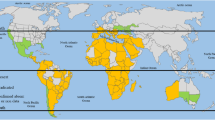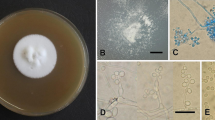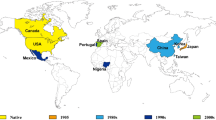Abstract
A leaf beetle, Crioceris sp. (Coleoptera: Chrysomelidae), was introduced into Australia as a biological control agent of bridal creeper (Asparagus asparagoides L. Druce) during October 2002. Rearing of Crioceris sp. is labour intensive therefore all releases of Crioceris sp. have been under 1000 individuals, which may be too low to ensure establishment if high mortality and high competition with other agents occurs. The aim of this study is to understand how the presence of two well-established biocontrol agents, a rust fungus (Puccinia myrsiphylli (Thuem) Wint [Basidiomycota: Uredinales]) and a leafhopper (Zygina sp. [Hemiptera: Cicadellidae]), might influence Crioceris sp. establishment. Crioceris sp. neonate larvae were placed on bridal creeper plants with or without the leafhopper and/or rust. The number of larvae that pupated was reduced by 38 and 65% in the presence of the rust fungus and leafhopper, respectively and by 45% in the presence of both agents. As the area infected by the rust increased the area damaged by the leafhopper decreased. The rust appeared to be negatively impacted by the presence of the leafhopper. In a second experiment, female Crioceris sp. adults were given a choice between uninfested bridal creeper plants and those infested with the rust or the leafhopper. The females preferred to lay their eggs on plants without leafhoppers but did not seem to be deterred by the presence of the rust. Consequently, the performance and impact of Crioceris sp. on bridal creeper may be reduced if populations overlap with the other biocontrol agents in the field.
Similar content being viewed by others
References
Awmack C.S., Leather S.R. (2002). Host plant quality and fecundity in herbivorous insects. Ann. Rev. Entomol. 47:817–844
Batchelor, K.L. and T. L. Woodburn, 2002a. The leaf beetle, Crioceris sp. (Coleoptera:Chrysomelidae), a potential biocontrol agent for bridal creeper in Australia. In: H. Spafford Jacob, J. Dodd and J. H. Moore (eds), Proceedings of 13th Australian Weeds Conference. Sept. 8–13, 2002, Perth, Western Australia. R.G. Richardson and F.J. Richardson, p. 402
Batchelor, K.L. and T. L. Woodburn, 2002b. Population development and impact of the bridal creeper leafhopper Zygina sp. in Western Australia. In: H. Spafford Jacob, J. Dodd and J. H. Moore (eds), Proceedings of 13th Australian Weeds Conference. 8–13 September 2002, Perth, Western Australia. R.G. Richardson and F.J. Richardson, Meredith, Victoria, pp. 381–384
Cronin J.T., Abrahamson W.G. (2001). Goldenrod stem galler preference and performance:effects of multiple herbivores and plant genotypes. Oecologia 127:87–96
Debouzie D., Heizmann A., Desouhant E., Menu F. (1996). Interference at several temporal and spatial scales between two chestnut insects. Oecologia 108:151–158
Denno R.F., Mcclure M.S., Ott J.R. (1995). Interspecific interactions in phytophagous insects:competition reexamined and resurrected. Ann. Rev. Entomol. 40:297–331
Denoth M., Frid L., Myers J.H. (2002). Multiple agents in biological control:improving the odds? Biol. Control 24:20–30
Ehler, L.E. and L. A. Andres, 1985. Biological control: exotic natural enemies to control exotic pests. In: C.L. Wilson and C.L. Graham (eds), Exotic Plant Pests and North American Agriculture. Academic Press, New York
Ehler L.E., Hall R.W. (1982). Evidence for competitive exclusion of introduced natural enemies in biological control. Environ. Entomol. 11:1–4
Fisher A.E.I., Hartley S.E., Young M.(2000). Direct and indirect competitive effects of foliage feeding guilds on the performance of the birch leaf-miner Eriocrania. J. Anim. Ecol. 69:165–176
Hokkanen H.M.T. (1985). Success in classical biological control. CRC Crit. Rev. Plant Sci. 3:35–72
Hunt-Joshi T.R., Blossey B. (2005). Interactions of root and leaf herbivores on purple loosestrife (Lythrum salicaria). Oecologia 142:554–563
Johnson S.N., Douglas A.E., Woodward S., Hartley S.E. (2003). Microbial impacts on plant-herbivore interactions: the indirect effects of a birch pathogen on a birch aphid. Oecologia 134:388–396
Karban R. (1986). Interspecific competition between folivrous insects on Erigeron glaucus. Ecology 67:1063–1072
Kluth S., Kruess A., Tscharntke T. (2001). Interactions between the rust fungus Puccinia punctiformis and ectophagous and endophagous insects on creeping thistle. J. Appl. Ecol. 38:548–556
Kok L.T., Abad R.G., Baudoin A.B.A.M. (1996). Effects ofPuccinia carduorum on musk thistle herbivores. Biol. Control 6:123–129
Kruess A. (2002). Indirect interaction between a fungal plant pathogen and a herbivorous beetle of the weed Cirsium arvense. Oecologia 130:563–569
Lawes Agricultural Trust, 2003. Genstat 7. In
Lawton J.H., Hassell M.P. (1981). Asymmetrical competition in insects. Nature 289:793–795
Milbrath L.R., Nechols J.R. (2004). Indirect effect of early-season infestations of Trichosirocalus horridus on Rhinocyllus conicus (Coleoptera: Curculionidae). Biol. Control 30:95–109
Morin, L., Willis, A.J., Armstrong, J. and Kriticos, D., 2002. Spread, epidemic development and impact of the bridal creeper rust in Australia: summary of results. In: H. Spafford Jacob, J. Dodd and A. J. Moore (eds), Proceedings of 13th Australian Weeds Conference. Sept. 8–13, 2002, Perth, Western Australia. R.G. Richardson and F.J. Richardson.
Paynter Q., Hennecke B. (2001). Competition between two biological control agents, Neurostrota gunniella and Phloeospora mimosae-pigrae, and their impact on the invasive tropical shrub Mimosa pigra. Biocontrol Sci. Technol. 11:575–582
Rostas M., Simon M., Hilker M. (2003). Ecological cross-effects of induced plant responses towards herbivores and phytopathogenic fungi. Basic Appl. Ecol. 4:43–62
Stiling, P. 1993. Why do natural enemies fail in classical biological control programs? Am. Entomol. 31–37
Tervet, I.W. and E. Cherry, 1950. A simple device for collection of fungus spores. Plant Disease Reporter 34: 238
Witt A.B.R., Edwards P.B. (2000). Biology, distribution, and host range of Zygina sp. (Hemiptera: Cicadellidae), a potential biological control agent for Asparagus asparagoides. Biol. Control 18:101–109
Witt A.B.R., Edwards P.B. (2002). Aspects of the biology, distribution, and host range of Crioceris sp (Col.: Chrysomelidae: Criocerinae), a potential biological control agent for Asparagus asparagoides in Australia. Biol. Control 23:56–63
Zar J.H. (1984). Biostatistical Analysis. Prentice Hall, New Jersey
Acknowledgements
CSIRO Entomology (Floreat, WA) is gratefully acknowledged for allowing us to use their glasshouse and laboratory facilities. We thank L. Morin for allowing us to use the pictorial key of rust infection she developed (Louise.Morin@csiro.au). The School of Animal Biology provided financial assistance. We thank two anonymous reviewers for their helpful comments in improving this manuscript.
Author information
Authors and Affiliations
Corresponding author
Rights and permissions
About this article
Cite this article
Spafford Jacob, H., Reilly, T.E. & Batchelor, K.L. The presence of Zygina sp. and Puccinia myrsiphylli reduces survival and influences oviposition of Crioceris sp.. Biocontrol 52, 113–127 (2007). https://doi.org/10.1007/s10526-006-9012-x
Received:
Accepted:
Published:
Issue Date:
DOI: https://doi.org/10.1007/s10526-006-9012-x




